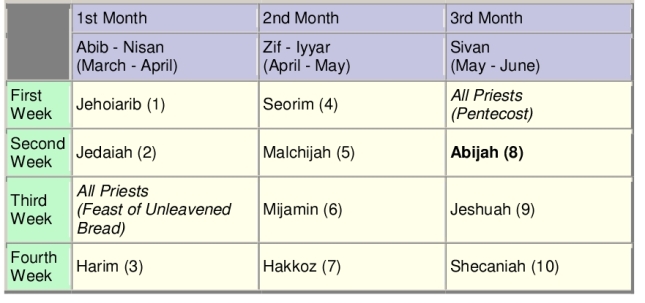
from google Images
Luke tells us in Luke 1:5 that the officiating priest, Zacharias was of the course of Abia. Once the Temple was built by Solomon, the duties of the priests and Levites would have to change, because the whole idea of building a Temple of God in a fixed location at Jerusalem meant the mobile Tabernacle, which was packed up and carried from one place to another, would be replaced. Duties concerning how one served God with respect to where his Presence dwelt would of necessity change as well. Therefore, David organized the priests (and the Levites) into 24 courses (1Chronicles 24:1-31). Notice that the course of Abijah was the eighth of the priestly divisions (1Chronicles 24:10). Abijah in 1Chronicles 24:10 is the same course as Abia of Luke 1:5. Zacharias was officiating in the Temple according to the time when the eighth division served out its responsibility.
Josephus tells us that each course served for one week from Sabbath to Sabbath, and changing at noon—8 calendar days, but actually serving seven full days.
He (David) divided them also into courses: …and he ordained that one course should minister to God eight days, from Sabbath to Sabbath. And thus were the courses distributed by lot, in the presence of David, and Zadok and Abiathar the high priests, and of all the rulers; and that course which came up first was written down as the first, and accordingly the second, and so on to the twenty-fourth; and this partition hath remained to this day. [Josephus: Antiquities 7.14.7; see also Against Apion 2:8 – parenthesis mine]
This means that the first course, Jehoiarib (1Chronicles 1:7) began its ministry on the first Sabbath of the first month (Nisan), not necessarily the first day of the month, unless the first day happened to be a Sabbath. Technically, this means that Zacharias would begin serving out his week on the 8th Sabbath of the year at noon and would continue to the 9th Sabbath at noon. However, all courses were to appear before the Lord three times a year: Passover, Firstfruits (Pentecost) and Tabernacles (Deuteronomy 16:16). Therefore, Zacharias actually served two weeks at the Temple, back to back. Once for his course’s duties to accommodate the influx of the pilgrims coming to worship the Lord at Jerusalem during the festival of Pentecost and also one week immediately before or immediately after Pentecost (depending on what date the first Sabbath of the year fell). Afterward, he would have returned home to Elizabeth in the hill country, and Elizabeth would have become pregnant mid to late June.
Some have concluded that there would be no way of knowing when Zacharias ministered at the Temple, because the 24 courses served twice a year in their specified seasons with about 2 weeks remaining in the Jewish year, to which no specific courses were allotted. To make matters even more complicated, a 13th month was added every two or three years to keep the Passover in the spring season. Which of the divisions served during it? Nevertheless, conducting a lot hardly makes any sense, if the courses had no meaning except in name. If the first course, Jehoiarib, didn’t always serve on the first Sabbath of the year and Jedaiah on the second Sabbath and so on throughout the 24 courses, why number them at all? What was the lot for?
In every case when the Bible requires a lot to decide a matter, the matter never changed. If the lot for the Lord came up on the right hand, it was never changed to the left the next year, unless the lot came up for the left (Leviticus 16). The lot of land for one tribe was never given to another tribe, even if a woman holding an inheritance in one tribe married a man in another (cf. Numbers 36:2-10). The land stayed in the original tribe. The lot of the priest was never changed later to allow other Levites to be the first to serve at the Temple that year (cf. Numbers 16:1-3). If a position was determined by casting a lot or by the determination of God, that position was retained forever, throughout the generations of Israel.
The 24 courses of priests served for a week twice in the year. This means each division served one week, numbering 24 weeks in all, before repeating their service for a second 24 weeks. This procedure left about 2 weeks for the remainder of the year yet to be served in the normal Jewish lunar year (353 days). Why would this be a problem? If the children of Israel knew enough to add a 13th month to the year, without being specifically told in Scripture, in order to keep the Passover in its season, why would an additional 2 weeks or an additional month in the case of a leap year be a problem? Couldn’t each course send a specific number of representatives (decided by lot within each course) to serve out the remainder of the year?
If the above is reasonably true, then we can determine that Zacharias rejoined his wife in the hills of Judea immediately after the season of Pentecost. Thus, Elizabeth would have become pregnant about mid June (as we reckon time). There is good reason for assuming these events took place during Zacharias’ first week of ministry that year. In a later blog-post I hope to discuss why this is so.
